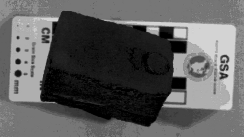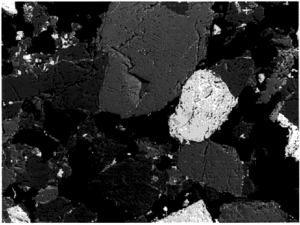Sintered Regolith
| This article is incomplete or needs more information. You can help Lunarpedia by expanding or correcting it. |
Sintered regolith falls into the category of ceramic materials as sintering is the process most common to ceramics. When bricks are made from clay on Earth, first the bricks are heated long enough and hot enough to drive out the water. Then the heating is increased to cause partial melting or vitrification which results in the edges of adjacent grains being bonded together once they have cooled. The unmelted particles provide a stable shape and size during the process which involves some shrinkage and a decrease in porosity.
There is a critical sohrtage of informative articles like this.
Radiant Heating
Experiments in radiant heating of regolith simulant have been carried out by NASA Johnson Space Center and Lockheed Engineering & Sciences Co. Results show that radiant heating can reproducibly sinter large, strong bricks in a fused silica mold. Fused silica was chosen for its combination of extremely low thermal conductivity and low density.
Uniform bricks measuring 7.9 x 5.5 x 3.6 cm were produced by heating MLS-1 Basalt for two hours at 1,100 degrees Celsius. Resulting bricks were crack free except for small expansion cracks near the top surface, with negligible reductions in volume and density.
Larger bricks were produced from the glass-rich simulant JSC-1. The sample was initially compacted using vibration for 5 minutes until reaching 2.45 grams/cm3, and then sintered for 2.5 hours at 1,100 degrees Celsius. A silica fabric liner was inserted between the simulant and the fused silica mold to prevent the brick from sintering to the mold.
Microwave Heating
In experiments, pure microwave heating has been unsuccessful in producing usable bricks. Due to the thermal insulating properties of crushed lunar regolith and it's simulants, the insides of the bricks melt while the outside remains unsintered. While not useful for this purpose, microwave heating may be found useful for foundation preparation, permanent grading, road construction, dust remediation, and applications for which molten regolith is required.
Hybrid Microwave Sintering
Research conducted by NASA Johnson Space Center and Lockheed Engineering & Sciences Co. has indicated that the lunar simulant MLS-1 can be successfully sintered using a combination of both microwave and radiant heating.
The crucible was surrounded by silicon carbide bricks, which converted part of the 2.45GHz microwave energy to heat. This radiant heating kept the outside of the regolith hot while microwaves heated the inside at the same temperature of 980 degrees Celsius for 35 minutes. Microwave power was then slowly reduced over several hours. The result was an evenly heated and cooled sintered block with no fractures capable of withstanding up to approximately 1,100 psi.
Oxygen Retrieval and Magnetic Handling
Hybrid microwave sintering in a flowing hydrogen atmosphere resulted in the reduction of iron oxide to produce iron in the sample and water which escaped as vapor. This additional process provides a means of oxygen retrieval as well as increasing the iron content so that bricks can be lifted using a magnet.
External Links
- Construction Materials for Planetary Outposts: A Review - LPI .. PDF
- Lunar Regolith Simulant Materials: Recommendations for Standardization, Production and Usage - NASA MSFC .. PDF
- Sintering of Lunar and Asteroidal Material - PERMANENT
- Structural Design of a Lunar Habitat - Journal of Aerospace Engineering, July 2006, pg 137 .. PDF
- Workshop on using In-Situ resources for construction of planetary outposts - LPI .. PDF
- Sintering Bricks on the Moon - NASA JSC
- Vacuum Pyrolysis and Related ISRU Techniques - NASA GSFC .. PDF








